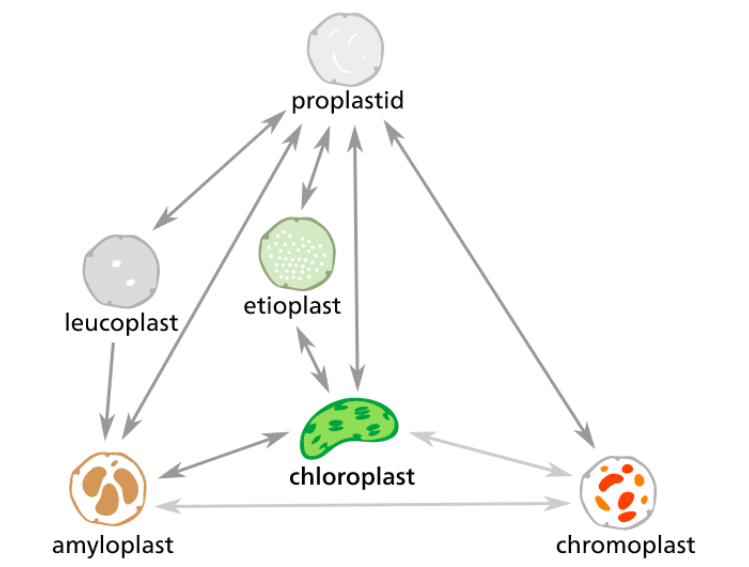
Explain briefly about plastids.
Answer
489k+ views
Hint: The cell is the basic structural, functional, and biological unit of all known organisms. A cell is the smallest unit inside the living organisms. Cells can be plant cells or animal cells.
Complete answer:
Plastids are double-membrane organelle which is present in the plant cell.
Plastids are mainly responsible for production and storing of food. They often contain pigments that are used in photosynthesis. These types of pigments in a plastid determine the cell's color.
The four main types of plastids are:
> Chloroplast: These green plastids are used for photosynthesis.
> Chromoplast: These colored plastids are used for pigment synthesis and storage.
> Gerontoplasts: It controls the dismantling of the photosynthetic apparatus during plant senescence.
> Leucoplasts: It is colorless plastids used for the synthesis of monoterpene.

Additional information:
We all know that a cell is the smallest unit or the basic unit of living organisms.
Two types of cells are:
1. Plant cell
2. Animal cell
1. Plant cell is the type of cell present in plants. Plants cells consist of following contents:
> Outer coverings
- Cell wall
- Cell membrane
> Nucleus
> Cytoplasm
> Protoplasmic Components
- Golgi bodies
- Mitochondria
- Chloroplast
- A single large vacuole
- Endoplasmic reticulum
- Peroxisome
- Ribosome
- Plastids
2. Animal cells are the type of cells found in animals. Animal cells consist of following components:
> Outer covering
- Cell membrane
> Nucleus
> Cytoplasm
> Protoplasm components
- Mitochondria
- Many small vacuoles
- Endoplasmic reticulum
- Golgi bodies
- Centromere
- Lysosome
Note: Plasmolysis is the process in which cells lose water in a hypertonic solution. So the turgor pressure decreases to that level where the protoplasm of the cell peel off from the cell wall and leaves the gaps between the cell wall and the membrane. This gap makes the plant cell shrink. A continued decrease in pressure leads to complete collapse of the cell wall.
Complete answer:
Plastids are double-membrane organelle which is present in the plant cell.
Plastids are mainly responsible for production and storing of food. They often contain pigments that are used in photosynthesis. These types of pigments in a plastid determine the cell's color.
The four main types of plastids are:
> Chloroplast: These green plastids are used for photosynthesis.
> Chromoplast: These colored plastids are used for pigment synthesis and storage.
> Gerontoplasts: It controls the dismantling of the photosynthetic apparatus during plant senescence.
> Leucoplasts: It is colorless plastids used for the synthesis of monoterpene.

Additional information:
We all know that a cell is the smallest unit or the basic unit of living organisms.
Two types of cells are:
1. Plant cell
2. Animal cell
1. Plant cell is the type of cell present in plants. Plants cells consist of following contents:
> Outer coverings
- Cell wall
- Cell membrane
> Nucleus
> Cytoplasm
> Protoplasmic Components
- Golgi bodies
- Mitochondria
- Chloroplast
- A single large vacuole
- Endoplasmic reticulum
- Peroxisome
- Ribosome
- Plastids
2. Animal cells are the type of cells found in animals. Animal cells consist of following components:
> Outer covering
- Cell membrane
> Nucleus
> Cytoplasm
> Protoplasm components
- Mitochondria
- Many small vacuoles
- Endoplasmic reticulum
- Golgi bodies
- Centromere
- Lysosome
Note: Plasmolysis is the process in which cells lose water in a hypertonic solution. So the turgor pressure decreases to that level where the protoplasm of the cell peel off from the cell wall and leaves the gaps between the cell wall and the membrane. This gap makes the plant cell shrink. A continued decrease in pressure leads to complete collapse of the cell wall.
Recently Updated Pages
Master Class 12 Economics: Engaging Questions & Answers for Success

Master Class 12 Maths: Engaging Questions & Answers for Success

Master Class 12 Biology: Engaging Questions & Answers for Success

Master Class 12 Physics: Engaging Questions & Answers for Success

Master Class 12 Business Studies: Engaging Questions & Answers for Success

Master Class 12 English: Engaging Questions & Answers for Success

Trending doubts
Who is Mukesh What is his dream Why does it look like class 12 english CBSE

Who was RajKumar Shukla Why did he come to Lucknow class 12 english CBSE

The word Maasai is derived from the word Maa Maasai class 12 social science CBSE

What is the Full Form of PVC, PET, HDPE, LDPE, PP and PS ?

Why is the cell called the structural and functional class 12 biology CBSE

Which country did Danny Casey play for class 12 english CBSE




